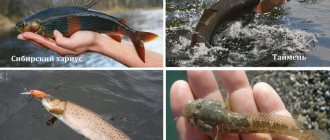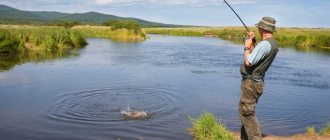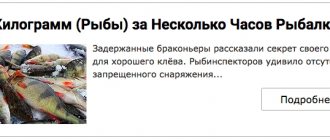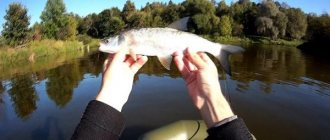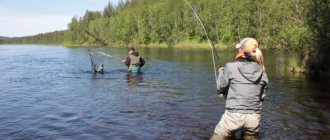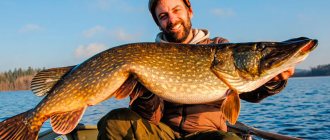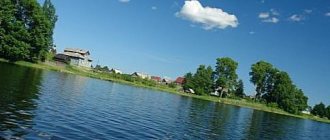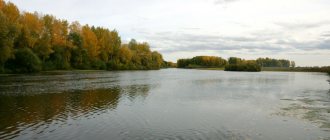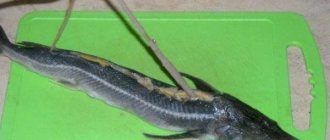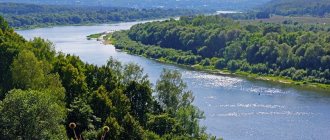Reservoirs of the Republic of Sakha
Reservoirs of Yakutia The
rivers and lakes of the region are home to more than 50 species of fish, the most valuable of which are taimen, nelma, Siberian sturgeon, chum salmon, pink salmon, grayling and some other species. The beauty of nature, unaffected by human economic activity, makes fishing in Yakutia attractive for avid fishermen who need not only trophies, but also relaxation for the soul. Most often people go to Yakutia to catch taimen. Taimen belongs to the salmon family, but, unlike other representatives of the family, it is a permanent river species and not an anadromous species. Accordingly, you can catch taimen all year round, and not just during the spawning period. The main method is fishing with a spinning rod, from the shore and while rafting down the river using spinners and wobblers, as well as a special taimen bait, an artificial “mouse”; it is no less successful to catch taimen using fly fishing gear. The usual perch and pike are also excellently caught in Yakutian reservoirs.
The region's territory is sparsely populated. The taiga stretches for many kilometers around. Transport links are poor. All this can create certain difficulties for independent fishing trips. It is much easier and safer to contact a fishing and tourism company that will help you choose the optimal tour in terms of duration and richness of impressions. If difficulties do not stop you and you are ready to go on an independent trip, then we recommend that you familiarize yourself in advance with the rules for recreational fishing in the Republic of Sakha Yakutia, the status of the reservoir you are going to go to, and local legislation on environmental management. A license may be required to catch certain types of fish.
The largest river in the region is the Lena with its tributaries Vilyui and Aldan. These rivers are the main waterways within the region, and are also the economic backbone of the Republic. There are about 30 large lakes in Yakutia. And only 10 of them have a surface area exceeding 100 km2. The majority of lakes are small and quite shallow.
There are many rivers in Yakutia where a wide variety of fish can be caught:
- Lena River - Both the Lena and its numerous tributaries are rich in valuable fish species. Whitefish, salmon and sturgeon thrive in this cold Siberian river. There are 12 species of fish that are considered world treasures. Fans of spin fishing will hunt here for grayling, pike, whitefish, lenok, burbot, and char. A very popular and interesting activity in these places is fly fishing for grayling. On the Lena, catching lenka weighing up to 6 kg, taimen 8 kg, pike from 17 to 20 kg, pike perch from 10-12 kg is not uncommon, but almost common. The best time to fish is from June to September. From July to September, whitefish, pike, lenok and perch bite well here. A good place for fishing is the Khangalsky ulus, located along the mouth of the Lena. Even a novice fisherman can fish here. The waters of the Lena will definitely reward him with a good catch. You can fish with a float rod, feeder, fly fishing, spinning rod, or donkey.
- Indigirka River. Fishing on this river gives good results. The waters of Indigirka are home to 27 species of fish. You can come here for such valuable species as taimen, nelma, whitefish, broad whitefish, musk, omul, lenka, grayling, etc. The climate here is very harsh, so not everyone would dare to sit here with a fishing rod or spinning rod. Local residents will tell guests for a long time, with interest, about the fish that are found in their native places. From them you can hear, for example, that in addition to the above-mentioned fish species, char or seruk also live here. True, in these places they are often caught not with a hook, but with snouts (muzzles). But, despite this, they will be able to tell a lot about fishing on Indigirka. Fishing for pike, taimen, grayling, burbot and lenok is carried out using a spinning rod, a float rod or donka, and other gear that is familiar to us. Other fish are rarely hooked. To catch here they use flies and shrimp.
- Olenyok River. People most often fish on this river in places from the mouth of the Alakit tributary and around the village of Olenek. The species that live in this river are different. Whitefish, lenok, taimen, nelma, burbot, tugun, grayling, burbot and pike are found in reaches along the entire course of the river. The most common fish here is taimen. Its average weight in this area is 15-30 kg, but there are also individuals weighing from 40 kg! The weight of grayling here is up to 3 kg, lenok – 406 kg, pike – 12 kg. A variety of baits are suitable. The best bait is the so-called artificial mouse. This is due to the fact that the fish in these places feed on rodents. The best time for fishing is August-September.
- Kolyma River. In this reservoir you can find almost all varieties of Yakut fish: sterlet, perch, beluga, smelt, grayling, ide, burbot, crucian carp, tugun, pike and, of course, roach. Rare species are also found here. For example, Siberian lampreys and sturgeon, chum salmon, pink salmon, peled, muksun. In total, the river is home to 30 species of fish. Promising areas for fishing will be: the confluence of the Kolyma and Omolon rivers; Eastern mouth of the river; Middle mouth. A variety of tackles and baits are used.
Who gets caught in Yakutia
The Sakha Republic is very rich in fish species. Many of them have the same roots as familiar fish, for example Chebak is a hybrid of roach.
List of the most popular fish:
- Lenok;
- Muksun – river fish, whitefish, salmon;
- Perch - many large specimens, small ones (6-9 cm) go as live bait;
- Pike is a frequent catch due to low temperatures in Yakutia;
- Chir;
- Limba;
- Arctic char;
- Lena gudgeon;
- Omul;
- Whitefish;
- Taimen (in the Red Book since 2009);
- Grayling;
- Burbot (caught mainly in winter, from November to March-April);
- Chebak (Siberian roach);
- Lena sturgeon;
- crucian carp.
Attention! Taimen is listed in the Red Book of the Republic of Sakha . Since 2010, criminal liability has been provided for catching Taimen in Yakutsk. Up to three years in prison or a fine of 1 million rubles, or work for 480 hours.
When catching taimen, we strongly recommend releasing the fish. Take care of the nature of our homeland.
The craft of fishing is the main source of food for the peoples of the Sakha Republic. Most of the fish is “exported” to other regions, the other part is consumed locally.
Often, the Yakuts do not even cook the fish, but dry it in the simplest way - “yukola”. The fish is cut into two parts, salted a little, and hung on wooden rods.
On large rivers you can catch whitefish, pike, grayling, chebak, perch, whitefish, and omul. Often you can accidentally catch hybrid trophy individuals.
On the tributaries of the Lena and Yana , in small outflows, large individuals are also caught. Most fishing takes place from the shore using a spinning rod, using jig baits, spinners, balancers, and flies.
In the north of the region, salmon can be found more and more often; large individuals are active in July-August.
general information
Fishing in Yakutsk
Hunting and fishing in Yakutia will delight everyone who is partial to active recreation. The republic is famous for its clean rivers and lakes full of fish of various species. Local fish is tasty and nutritious.
Catching taimen is good luck for a fisherman; especially large specimens can reach a weight of 30 kg and a length of one and a half meters. Taimen is a member of the salmon family. This fish lives only in the cleanest water; it prefers fast mountain rivers and lakes. The best time to catch taimen is immediately after spawning, late May - early June. It is also quite good to catch in the fall, with the arrival of September and right up to the first frost. The summer bite is weak. The main method of fishing is using a spinning rod with bait.
Pike is the most common predator in the reservoirs of Yakutia. Pike is easier to catch than taimen, grayling or lenok. Small fish prefer shallow water off the coast, closer to the thickets, and large individuals love deeper places. Older pikes can reach large sizes and weigh up to 50 kg. Spawning time for pike comes with the arrival of spring. Pike hunts not only small fish, but also small waterfowl, as well as frogs. Pike fishing in Yakutia is carried out using a spinning rod. A spinner or wobbler is used as bait. In small rivers it is possible to catch pike with a frog.
Fishing on the Lena River and its tributaries
The high water content of the Lena River is due to the large number of tributaries, in the depths of which valuable representatives of the salmon, whitefish and sturgeon families live. The population of nelma, muksun, vendace, omul and sturgeon prevails over the total number of representatives of other species living in the Lena River.
Buotama is a right tributary of the Lena River. The main fishing season on the river lasts from June to September. The river is home to whitefish, pike, grayling, lenok, dace, and pike, which become prey for spinning fishing. On the cape formed by the main river and its tributary there is “Ust-Buotama”, a nursery for forest bison. Not far from the nursery there is a tourist base of the same name. An alternative place for fishing can be the territory of the Khangalassky ulus adjacent to the city of Pokrovsk along the mouth of the river.
The Lena River basin serves as the location of the Chara River, the right tributary of which is the Tokko River, located in the Olekminsky district. Near the city of Olekminsk there is a recreation center from which fishing tours are carried out from June 20 to September 20. Rare specimens of taimen, found in the Tokko River and active in the spring, are a coveted trophy for experienced fishermen. The abundance of grayling, pike, lenok and other types of river fish justifies the popular name of the river “The Place Walked by God.”
The Dyanishka, Belyanka and Undyuling rivers are right-hand tributaries of the Lena, located in the Kobyaisky ulus, which have gained fame as habitats for taimen, which do not stop feeding when the water level in the river changes, unlike other fish species. Thus, the most common type of fish is represented by taimen. The “master of the river” (taimen) is caught while rafting down rivers using a spinning rod from late spring to autumn.
The second place in the number of individuals is occupied by lenok, third by pike, fourth by perch, and fifth place is shared by limba and grayling. The small river Lyapiske (Lyapushka) flows into the mouth of the Lena from the right bank. Experienced fishermen have chosen it as a place for sport fishing, the main purpose of which is to catch the Siberian Taimen, a large Asian salmonid. Pike, lenok, whitefish and perch actively bite during the period from July to September, together giving a hefty catch.
Fishing on the Aldan River
Fishing in the Sakha Republic
The Aldan River is a powerful right-bank tributary of the Lena, which is divided into upper, middle and lower parts according to geography. The Tumara River flows into the upper Aldan, where taimen, East Siberian grayling, pike, whitefish, burbot, perch, ruff, lenok, whitefish, river minnow and chebak live. In the middle and lower parts of Aldan, all representatives of the upper part are common, as well as the Siberian sturgeon (khatys), nelma, tugun, Siberian lamprey (loach), Siberian roach (saroga) and vendace (konderovka). The Kele River, a small tributary of the Aldan, deserves special attention, combining all the fish species characteristic of the Aldan.
Fishing on the Morcoca River
The right tributary of the Markhi River in the Vilyuy basin is the Morkoka River, located in the Mirny district. The surface of the Markoki River is unstable, but the water columns hide trophy-sized representatives of taimen, lenok and pike, which are caught by experienced fishermen between August and September.
The Vilyui Reservoir is a reservoir known for its purity, diversity of species and the number of their representatives, as well as for hosting sport fishing tournaments. Fishing for trophy pike, perch, pike and peled, carried out in September, is the lot of experienced fishermen guided by a sporting interest.
The harsh Siberian conditions force fishermen who want to try their luck on Sakhi to come to terms with the lack of such comforts as a permanent tourist base or land communication routes with nearby settlements. But in return, adherents of extreme fishing in Yakutia, whose fishing spots are given the opportunity to see live the splendor of northern nature from a bird's eye view.
Gear device
The design of winter tackle for jig fishing cannot be called complicated: a short winter fishing rod, a fishing line, an alarm and the bait itself. It would seem nothing complicated, but combining these elements into an effectively working system is not so simple: they must be optimally matched to each other. Moreover, the leading element in this case is the bait: its weight, configuration, presence/absence of bait determines the characteristics of other components of the equipment.
In the cold, selecting elements is quite problematic, and you don’t want to waste time on it, so experienced winter skiers take several fishing rods with different jigs for fishing at once, and determine on the spot which one is best suited to the current conditions.
For a beginner, two or three equipped gears are enough. They are not too expensive (remember, we are talking about amateur fishing), so you can afford them from the start.
Fishing rod
The main and most expensive element of the equipment is the fishing rod, although the price of the issue is also low - about 300 rubles maximum. The length of the fishing rod is a maximum of 30 cm, the weight is less, the better (from 15 to 120 grams). Lightness is especially important when fishing for the game - stationary fishing can also be done with heavier gear.
The most common type of fishing rod is the “balalaika”, which is convenient in all respects (the reel with a closed body is also a handle). Axle-free options with a reel-handle, which is a ring, are also good. If you are going to fish with a jig in a stationary way or catch a large predator for the game, you can also use heavier fishing rods with reels distanced from the handle (the so-called winter spinning rods).
By the way, some fishermen, for the sake of lightness of gear, refuse reels altogether. In this case, a structure for winding up the fishing line (hooks or notches) is provided on the cork or foam handle. However, you need to understand that it will not be possible to protect an open fishing line from freezing, and this automatically leads to a loss of sensitivity and an increase in the weight of the gear.
fishing line
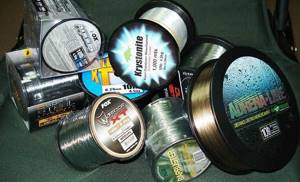
The main criteria in this case are maximum load capacity with a minimum diameter, as well as stealth in water. The thinnest equipment should be used in the dead of winter, when the fish are inactive.
The most commonly used is special winter monofilament or fluorocarbon. Fluorocarbon is usually more expensive, but when fishing with a jig, line consumption is minimal, so you can afford such a “luxury”.
In mormyshing, fishing line with a diameter of 0.05-0.12 mm . However, the thinnest thread is used mainly by athletes, and is rarely used in amateur fishing. It is recommended to equip three tackles with fishing line of different diameters: 0.07-0.08 mm, 0.1 mm and 0.12 mm. The second option is considered the most universal and suitable for a wide range of conditions. The first option is optimal for fishing at significant depths and in the dead of winter, the second - for shallow depths and fairly heavy baits.
Alarm
In most cases, the role of a signaling device is played by a nod (guard). This element was previously made from boar bristles, now mainly from lavsan or metal tape. Mylar nods are considered more sensitive, which ensures the most realistic game and quick reactions, but in strong winds it is difficult to distinguish a bite.
The length of the guard is selected depending on the type of animation: the longer the nod, the softer and lazier the game. For example, for bream you will need a longer guard, for a fan of the sharp game of perch - a shorter one. Choosing a nod for a reelless bait is even more difficult: most of the points are learned from personal experience, because each bait of this type behaves differently in the hands of different anglers.
It is considered that the guard is adjusted correctly if, under the weight of the bait, it bends at an angle of about 45°C. But this, again, is not an axiom: the main indicator of the correct setting of the nod is effectiveness, and this can only be understood through experience. Moreover: in baitless fishing, the most sensitive gear without a reel or nod is often used, because sometimes the animation is set even by tapping a finger on a miniature handle made of foam or cork.
Stationary fishing with a jig can also be float-based even in winter and ice conditions, and the alarm is adjusted to float. As in all other cases, the carrying capacity of the float is adjusted to the weight of the bait.
Winter fishing
Many fishermen prefer harsh winter fishing. Three different methods of fishing in winter have become widespread in Yakutia.
Munha – ice fishing using a seine. To do this, a hole is found or made, from which nets are lowered under the ice. At the same time, you need to make another hole from which the nets will be pulled out. Between two holes, small holes are drilled on both sides for pulling through nets. If the catch is small, the nets are launched again.
Kuyuur is a tackle that resembles a large net. This fishing method is suitable for fishing for small fish. First you need to find the right place where the fish spend the winter. After this, a hole is drilled into which the fishing gear is lowered and rotated there. The resulting water whirlwind captures the fish and carries it into the net. After the kuyuur is filled, it is removed, the catch is taken out and lowered back into the hole.
Fishing with a rod is the most traditional way of winter fishing. You can also use a smaller spinning rod with a reel. It is important to choose the right fishing rod and additional accessories (hooks, floats). In the chosen place, the fisherman drills a hole into which he lowers a fishing rod with bait. The gear should not be allowed to become icy.
The essence of jig fishing
A jig in the classical sense of the word is an artificial bait that imitates a miniature amphipod crustacean. This crustacean (along with bloodworms) is the basis of the food supply for all peaceful and some predatory fish in the winter. True, modern baits of this class have significantly moved away from living prototypes, acquiring very intricate shapes and colors. However, the essence and basis of the design remained the same: a metal “body” that plays the role of a spinner and a weight, and a hook (or several) implanted into it.
This bait provides a rich catch even with a bad bite! More details Initially, jigs were intended exclusively for bait fishing: they were necessarily used in tandem with edible baits. Fishing was carried out mainly stationary: the fishing rod was installed above the hole, at which point the fisherman’s actions ended. Later, fly fishing appeared: during it, the angler does not let go of the fishing rod, manipulating it and playing with the bait. This serves to additionally attract fish - it responds to both movement and acoustic signals.
Winter fishing with wire has become so popular that it has initiated the emergence of a new class of baits – reelless baits. These are jigs that work solely due to the game - the presence of edible bait is not expected at all.
In addition, such baits are also used for alternative types of fishing. For example, to catch white fish in strong currents using bottom gear (“helicopters”, “droppers”), baits of this class are used on diverting leashes. In this case, a large weight is hung on the main line, fixing the equipment relative to the bottom, and several light jigs are mounted on the outlet leash. There are other options for equipment.
By the way, they can successfully catch fish with jigs in the summer, mostly vertically from a boat or a steep bank. In a word, we have before us a truly universal bait, you just need to learn how to choose it rationally and use it wisely when fishing.
Features of fishing
Fishing in Yakutia
Fishing in this area is more important than hunting. There are a lot of fish in the rivers located in Yakutia. And, most importantly, it belongs to valuable breeds. Fish in these parts is the main form of both income and food. In Indigirka there is such a fish as omul. This river is famous for the size of such fish. Local omul are harvested exclusively for themselves. The quality of omul can be understood at least from the fact that yukola is made from it. Of course, this dish is made from pike, but here, in the north, only dogs will eat pike, and then only in a hungry year. Yukola itself is dried fish without spices, salt or heat treatment. In winter, when hunting or fishing, one or two of these fish will be enough to get your fill.
Another feature of fishing in Yakutia is a fish called grayling. You can see its attack on the sandy bottom. Fresh grayling baked on coals is the best dish you can come up with from this fish. And if you add the smell of the autumn tundra, the absence of people for several hundred kilometers, beautiful calm weather, then the taste of the dish becomes unique and indescribable. Northern fish, especially in those parts, does not carry any infection, and it can be eaten raw, which is what the local people actually do.
You can't fish here without catching a chebak. This is apparently what they call the rudd here. What can you do if the water around you starts to boil! Loud gurgling around will bring any fisherman to his fishing rod.
Fishing for taimen in Yakutia is also worth discussing. Among true connoisseurs of fishing, catching this fish is very popular. It is best to catch taimen using a spinning rod after spawning, in early summer, since at this time it greedily swallows any bait. Most often, taimen can be found at the mouths of small rivers, near large stones and rifts. It is better to catch this fish on cloudy and windless days, since in sunny weather the probability of catching taimen is very low. It is worth considering that when catching this type of fish, the spinning rod must be strong and rigid. Since the fish are adapted to the local climate, winter fishing in Yakutia brings good results.
Features of fishing for different types of fish
As mentioned above, there are no universal baits and wiring; the choice depends on many factors. But, for the most part, white fish like smooth movements with a large amplitude and decent pauses, while the predator prefers a more active and sharp game.
Let's go over the preferences of the main potential trophies:
- Bream . Bream is practically inactive in winter, so only experienced fishermen deliberately hunt for it. Usually medium jigs with bloodworms are used. In the dead of winter, it is most effective to fish “on the riser” (without playing) at night, with abundant feeding of dumps and edges near the wintering pits. In the hands of professionals, a medium-sized mothless reel will also work in the hands of professionals.
- Roach . The roach is a common trophy for winter anglers: this fish remains relatively active even in the bitter January frosts. Active search tactics work best, with the exception of very deep winter days. It is best to catch this fish using ultra-light fishing rods without reels and a jig with a nozzle made of bloodworms or maggots. For the first and last ice, you can experiment with a rewinder. Smooth play without sudden jerks is welcome.
- Crucian carp . Crucian carp, especially large ones, are not very active in winter. The golden one bites extremely rarely, but the silver one can be hunted. For this, the simplest and most inconspicuous jigs are usually used, without bright accessories, but the attachment must be extremely appetizing. Mothless fishermen rarely go after crucian carp purposefully.
- Perch . The voracious sailors are not particularly whimsical and are active at any time of the year; the humpback whale is much less common. Perch loves mud, so any fishing should include tapping on the bottom. In the wilderness, a monotonous game is used, at other times it is more chaotic. You can experiment with wiring as you like. When fishing with a reelless bait at great depths, bright colors and a very clearly marked attack point (like a bead in a “cat’s eye”) are welcome.
- Pike . To catch toothy torpedoes, super-heavy baits are used, which are jigs only in name. Rather, these are winter lures, the gear (winter spinning rods) and wiring used are similar. When using cone-shaped baits, an addition is necessary in the form of pieces or whole fish, bunches of worms (sometimes they use all sorts of exotic things like painted udders). We must not forget about the need for a leash: in the first ice, you can use a metal one, but in the dead of winter it is better to replace it with fluorocarbon.
- Sudak . The use of heavy jigs is especially effective in the dead of winter, when purely artificial baits such as winter spinners or wobblers do not attract fanged fish. Jig heads for silicone baits and “Uralkas” with sprat bait are often used as jigs. Fishing is usually carried out “on the riser”, downstream. Of the mothless species, the “devils” perform well. At great depths, fluorescent baits are good.
- Burbot . Freshwater cod treats the winter season very favorably: it is active, catches well with heavy jigs, and becomes especially active on the eve of spawning, which occurs in February. A fairly rigid fishing rod for winter trolling is suitable as the basis of the equipment. The jig used is extra heavy, several tens of grams, always with a refill of fry or sliced fish. As complementary food, water with fish remains (blood, giblets, scales, etc.) is poured into the hole. The main wiring is tapping the bottom. The main thing is to find the burbot’s parking place, which is problematic without an echo sounder.
see also
|
|
|
Important little things
| Nods made of various materials: A - spiral spring; B - steel plate and spiral spring; B - thin plastic plate; G - spiral spring and boar shield; D - lavsan plate with a head. |
As in any business, the success of jig fishing sometimes depends on the little things. So, a piece of ice frozen on the fishing line can let you down. More often than not, a piece of ice freezes where the knot is tied. In this case, the movements of the nod gradually change and the jig begins to play no longer the way the angler would like. Therefore, icing of the fishing line should not be allowed. It's easy to fix - you just need to pass the fishing line between your fingers, it will become clean.
Usually, when biting, the nod bends downward - in most cases, the fish takes the jig after it, pulling it to the bottom. The pull-up can be quick and energetic, sluggish, or consist of several small pull-ups - it depends on the type of fish and its condition, and not just on the size. Sometimes even a half-kilogram perch bends its nod just a little, and it happens that a small roach tugs so energetically that you think: a big perch has bitten.
| Approximate nod load under the jig |
If the fish pulls to the side, then the nod also lowers - after all, the line goes almost vertically to the bottom edge of the hole, and only with thin ice can the nod turn to the side. It happens that you recognize a bite by the straightened nod. This is how bream bites, for example; in many places - roach. This also happens if the fish grabs the falling bait and does not move from the spot. This can happen at any depth, even just below the bottom plane of the ice. This means that straightening the nod is a signal for hooking.
Often the bite is so weak and unnoticeable that you cannot understand whether the nod trembled a little, or the wind slightly shook the line, or some fry touched the nozzle. There are such bites that the nod does not bend at all, you only find out about them because the line has slightly straightened in the place where it comes out of the nod. Of course, this happens mostly in the dark.
From these factors, the conclusion suggests itself: it is necessary to hook in case of any suspicious behavior of the nod, even if it only flinched a little, stopped playing or bent slightly to the side. In the overwhelming majority of cases, it turns out that it was a bite and there was a fish on the hook. It also happens: a nod signals a sharp bite, but after hooking not only the fish, but also the bait is not on the hook. This happens when the fish only takes the bait into its mouth. Such bites occur not only during weak bites, but also during feeding hours.
